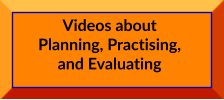
How to Practise
Learning
to
drive
safely
takes
practice
-
lots
of
practice.
No
one
would
spend
a
session
with
a
coach,
whether
arts
or
athletic,
and
then
not
practise.
It’s
the
same,
or
even
more
for
driving
-
skipping
practice
on
a
piano
or
on
the
rink
is
not
as
dangerous
as
skipping
practice in driving.
Parents
/
Guardians
should
also
be
aware
that
Driving
Lessons
are
done
in
a
mid-size
sedan,
and
while
it
is
certainly
advantageous
to
use
one
of
our
cars
for
the
Road
Test
(the
Learner
Driver
is
familiar
with
the
car
and
the
Driver
Examiners
prefer
a
test
car
with
two
sets
of
brake
pedals),
it
is
unwise
to
believe
that
a
Newly
Licensed
Driver
who
has
only
driven
a
mid-size
sedan
can
now
safely
get
behind
the
wheel
of
a
massive
SUV,
van
or
pick-up
truck
without
an
experienced
driver
to
help
them
learn
how
to
handle
that vehicle.
So where to begin?
First
is
planning
-
think
ahead
to
make
the
practice
session
safe
and
successful.
Remember
that
the
Learner
Driver
has
been
learning
in
a
mid-size
sedan
-
if
you
can
arrange
for
them
to
practice
in
a
similar
sized
car
until
they
pass
their
Road
Test,
it
will
be
very
helpful.
Decide
in
advance
where
you
are
going
and
what
you
are
going
to
do.
Also
decide
in
advance
how
you
are
going
to
get
to
the
practice
area
-
if
you
need
to
pass
through
downtown
Halifax
in
order
to
get
to
a
quiet
subdivision,
then
the
Supervising
Driver
should
drive
to
the
practice
area,
and
on
the
way
the
Supervising
Driver
can
point
out
and
discuss
the
potential
hazards
and
situations
that
they
are
monitoring while they drive.
Second
is
communication
-
keep
it
simple
and
calm.
Too
many
directions
from
the
Supervising
Driver
will
only
frustrate
and
confuse
the
Learner
Driver
-
sometimes
the
best
practice
is
to
let
the
Learner
Driver
tell
you
what
they
are
doing
and
what
they
are
watching
for.
Encourage
the
Learner
Driver
to
explain
to
you
what
they
learned
in
their
last
driving
lesson;
this
will
not
only
help
the
Learner
Driver
recall
and
focus
on
what
he
or
she
has
learned,
it
will
help
the
Supervising
Driver
understand
what
is
going
on and what practice is required.
Third
is
evaluation
-
how
will
you
know
when
the
Learner
Driver
has
mastered
a
skill,
or
needs
more
practice
with
a
skill,
or
is
getting
frustrated
and
needs
to
return
to
practising
that
skill
at
a
later
time?
Here
is
a
link
to
a
number
of
videos
about
planning,
practising
with and evaluating a Learner Driver.













